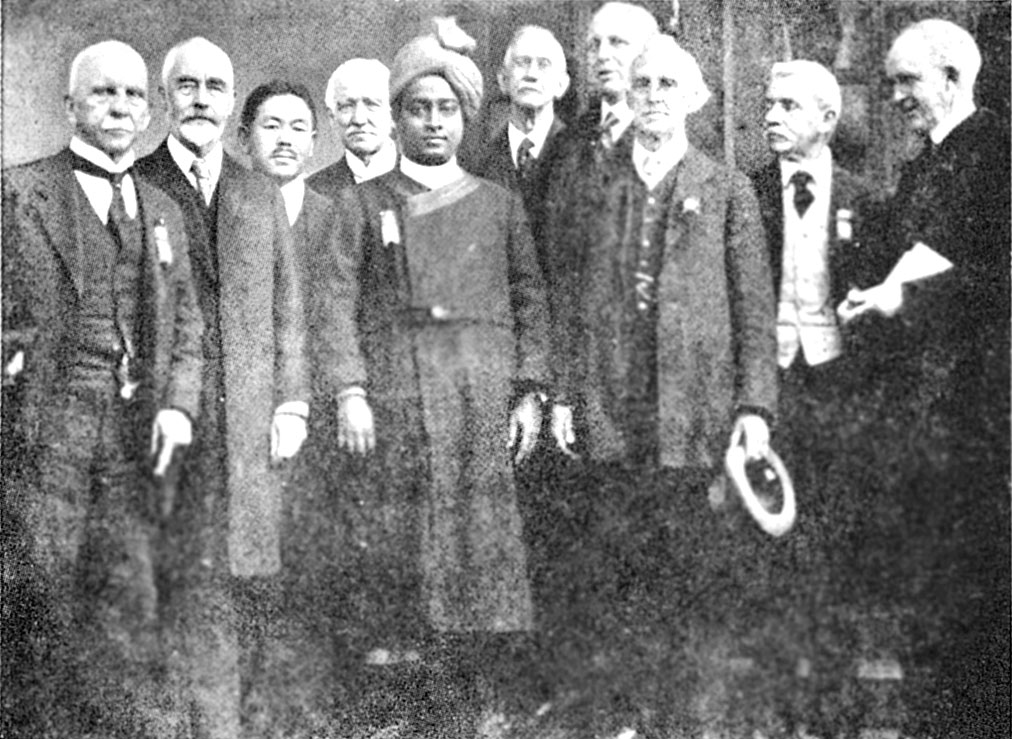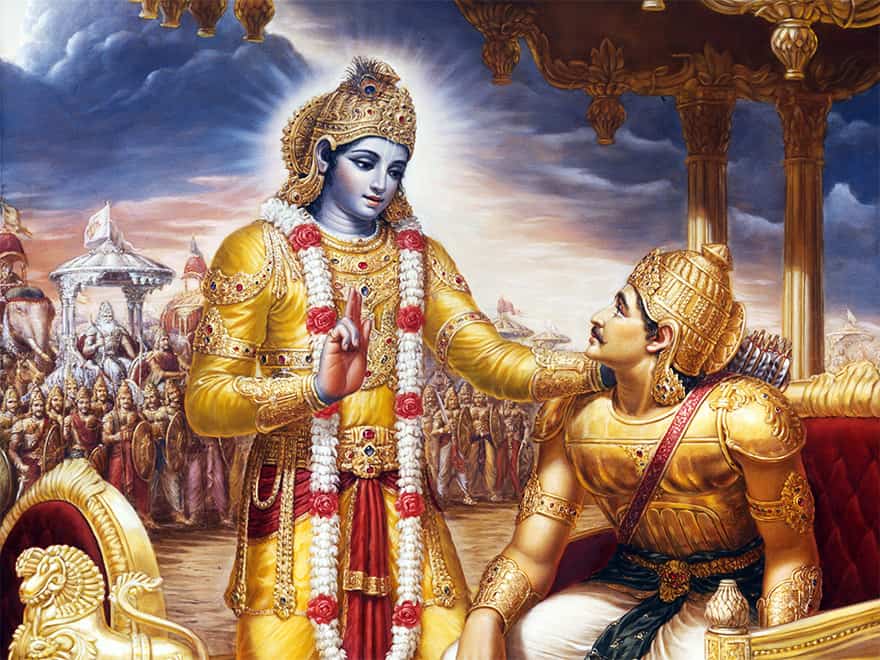“Oh, East is East, and West is West, and never the twain shall meet…”
Rudyard Kipling, “The Ballad of East and West
This line, from the well-known poem by Rudyard Kipling, is often misquoted by those who maintain that there is an irreconcilable difference between the Eastern and Western cultures and that any reciprocal understanding is impossible. In fact, the poem’s opening stanza reads:
Oh, East is East, and West is West, and never the twain shall meet,
Till Earth and Sky stand presently at God’s great Judgment Seat;
But there is neither East nor West, Border, nor Breed, nor Birth,
When two strong men stand face to face, though they come from the ends of the earth!
Interestingly, Paramhansa Yogananda was aware of this poem and mentions it in one of his informal talks (“Beholding the One in All”). He states: “And Rudyard Kipling said that East and West, the twain never will meet. Well that’s true. If the East and West were made of the same pattern, they couldn’t learn from each other. It’s because they’re different that they can learn from each other. But two other lines of Rudyard Kipling are never quoted: that when a strong man of the East and a strong man of the West meet, the twain will always meet. When understanding people of East and West come together, they will find a common ground of understanding. In the East, we emphasize more meditation, more calmness. In the West, building of the hive. But both the hive of material life and the honey of peace are necessary. And when you balance them, then we find happiness.”
We should remember that Yogananda’s mission to the West was to promote this very understanding between East and West. It is not without significance, for example, that the magazine he founded and first published in 1925 was entitled “East-West”. He was sent to the West by Mahavatar Babaji, as he explains (in The Second Coming of Christ, p.xxviii): “To reveal the complete harmony and basic oneness of original Christianity as taught by Jesus Christ and original Yoga as taught by Bhagavan Krishna; and to show that these principles of truth are the common scientific foundation of all true religions.”
We might also remember in this context the illuminating passage from the Autobiography of a Yogi (p.326.), in which Babaji approves, we are told, of Sri Yukteswar’s interest in the East and West and in which he talks of the coming harmonious exchange between Orient and Occident. Babaji promises to send Sri Yukteswar a disciple (Paramhansa Yogananda) to train for disseminating yoga in the West and adds: “East and West must establish a golden middle path of activity and spirituality combined. India has much to learn from the West in material development; in return India can teach the universal methods by which the West will be able to base its religious beliefs on the unshakeable foundations of yogic science.”
Yogananda was not unaware of the difficulty of his mission. “Many writers in the West,” he says (in God Talks With Arjuna. The Bhagavad Gita, p.504), “condemn the science of Yoga on the false grounds that it is unsuited to Westerners. Science knows no East or West. In the past, many orthodox Hindus condemned disinfected water conveyed by pipes (introduced by the English) as ‘sinful, heathen’ water; electricity was branded ‘evil and destructive’ energy! But all Hindus now like ‘heathen’ water better than their polluted malarious well-waters; they also prefer ‘evil’ electricity to their old dim oil-lamps… The unreasonable objections of the Hindus to Western science were no more discreditable than the ignorant condemnations uttered by certain Westerners about the time-honoured science of yoga.”

In the hundred years since Yogananda’s arrival in America aboard the steamship “City of Sparta” in September 1920, yoga (albeit in its more physical aspect of hatha yoga) has become part of the western consciousness thanks to the efforts of Yogananda and other enlightened yogis who have disseminated the yogic science in the West, and words such as “guru”, “karma”, “chakra”, “kundalini”, “asana”, “prana”, “maya”, “mantra”, “samadhi” etc. are now common in everyday Western languages. However, it seems more time will be required until, as Babaji said, “the West will be able to base its religious beliefs on the unshakeable foundations of yogic science.”
And during those same hundred years, India, which seems to have epitomized the East for both Babaji and Yogananda, has developed economically and scientifically into a modern democratic state, partly due, no doubt, to Western influences. What effect this material development has had on India’s spiritual foundations is more debatable. As often happens, the pendulum swings to its other extreme before finding its point of equilibrium. I refer simply to the observation made by Kriyananda in his book Visits to Saints of India (p.7) to the effect that during his many visits to India over the course of nearly fifty years (from 1958 to 2003), he found fewer and fewer saints with each new visit. He affirms his belief, however, that “the sacred vibrations of India will rise triumphant, at last, over the mists of materialism that now swirl like brume upon the earth here.”
Perhaps one hundred years are not sufficient for East and West to establish the “golden middle path of activity and spirituality combined”, which Bababji envisaged. Yet, as Kipling’s poem states and as Yogananda explains, when “two strong men” meet, though they be from the ends of the earth, the differences of East and West cease to exist and the two will always find a common ground of understanding. And the question naturally arises as to what it is to be “a strong man”, whether from East or West, for whom there is neither East nor West.
Yogananda, as we said, was specifically charged by Babaji with the mission of introducing in the West a knowledge of ancient yoga techniques by which man can enter into conscious communion with God. And before sending him to the West, Babaji tells him (Autobiography of a Yogi, p.337): “Kriya Yoga, the scientific technique of God-realization, will ultimately spread in all lands, and aid in harmonizing the nations through man’s transcendental perception of the Infinite Father.” Kriya yoga, therefore, is not only presented as the key to God-realization on the part of the individual (the strong man), but also as an aid to international harmony. And, perhaps, the analogy between the practice of Kriya yoga and the harmonizing of East and West can even be taken a stage further.

Krishna tells us in the Bhagavad Gita (IV, 29): “Other devotees offer as sacrifice the incoming breath of prana (life energy) in the outgoing breath of apana, and the outgoing breath of apana in the incoming breath of prana, thus arresting the cause of inhalation and exhalation by intent practice of pranayama (control of life-energy).” (tr. Paramahansa Yogananda). This verse, according to Yogananda, is a clear description of the technique of Kriya Yoga by which the soul can be released from identification with the body and united to Spirit. For the kundalini energy, dormant at the base of the astral spine to rise in the sushumna (the deep astral spine, the middle path) and bring about this goal, the life-force in the two astral nadis (channels) on either side of it (ida on the left and pingala on the right) has to be neutralized by offering the inhaling breath (rising in ida) into the exhaling breath (descending in pingala). This control of the breath, or better, of the life-energy (pranayama), is the basis of Kriya Yoga.
This neutralizing of the life force in the left and right nadis of the astral spine in the human body leading to the rising of the kundalini (occult) energy and to the union of the individual soul with the infinite Spirit can also serve as a useful analogy for the union of East and West leading to world harmony. It would not be too far-fetched to identify the prana rising in ida (like the sun, as life-energy, rising in the East) and the apan descending in pingala (the sun setting in the West) with geographical East and West. In the same way, the offering of the rising current of energy into the descending current of energy and vice-versa (required for the individual to identify with the Spirit) might easily serve as an image for the harmonious cooperation of East and West (required for establishing the golden middle path of activity and spirituality).
And to conclude with one final thought on the image of the two strong men coming from opposite ends of the earth for whom there is neither East nor West, we may simply reflect that the yogic belief in reincarnation means that the westerner in this lifetime may very well be the easterner in the next and vice-versa. In fact, Yogananda (Man’s Eternal Quest, vol. 1, pp. 223-4) states quite openly: “Many souls from the East have reincarnated now in America. Desiring material perfection, they have been born here to enjoy the fulfillment of that desire and to help encourage American spiritual ideals. Similarly, many souls that formerly were born in America have since reincarnated in India in order to benefit from her spiritual riches and to help India in the development of the material side of her civilization… This world is God’s family. He is trying to improve all nations. He has no preference for one over another.”
Amen, Amen, Amen,
Sanjaya
